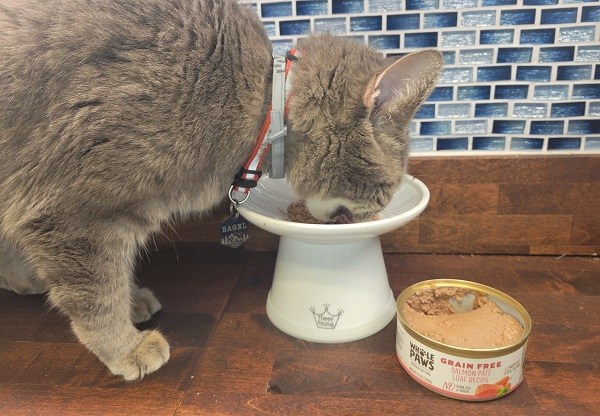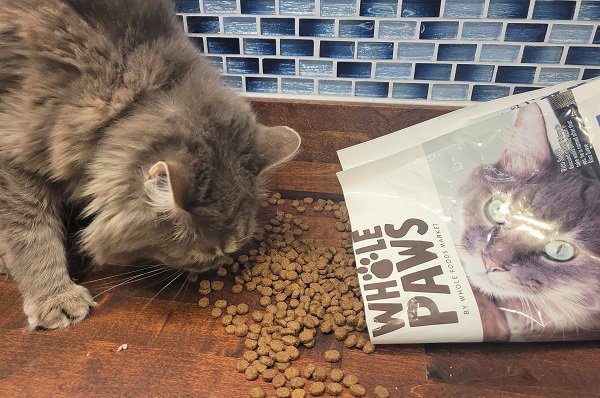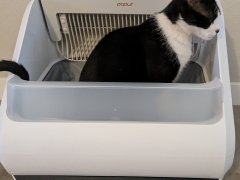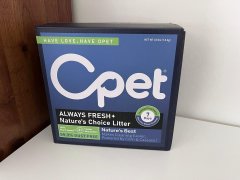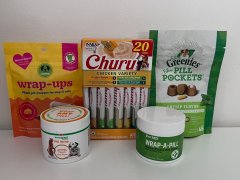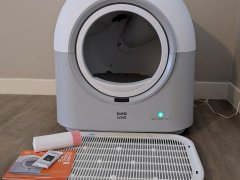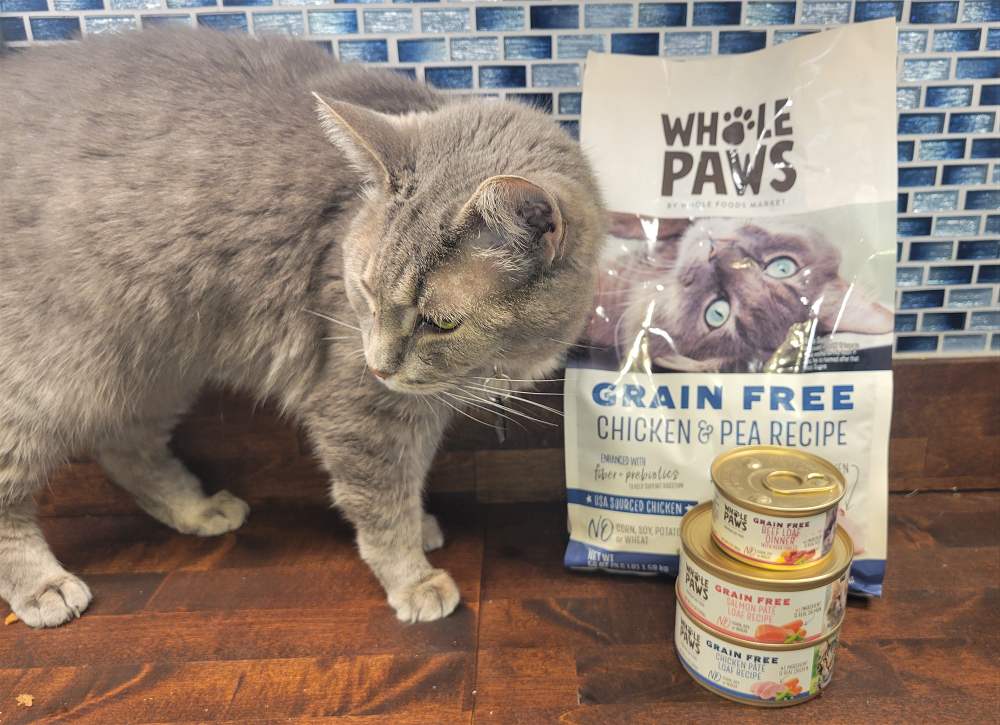
Kate Barrington / Cats.com
Whole Paws is the private-label pet food brand of Whole Foods Market. Whole Foods has a reputation as the go-to grocery for healthy products and specialty food items, but how does their pet food compare? We took a deep dive into Whole Paws cat food to find out.
The Cats.com Standard—Rating Whole Paws Cat Food on What Matters
We’ve rated the brand on six key criteria for quality. Here’s how it rates in each of these six crucial areas.
Ratings
- Species-Appropriateness – 7/10
- Ingredient Quality – 8/10
- Product Variety – 7/10
- Price – 7/10
- Customer Experience – 8/10
- Recall History – 9/10
Overall Score: 7.6/10
In total, we give Whole Paws cat food a 46 out of 60 rating or a B+ grade.
Why Trust Cats.com
Before writing this review, I performed in-depth research on the Whole Paws pet food brand, including its history and product selection. My research spanned the Whole Foods Market website and social media accounts, as well as pages dedicated specifically to the Whole Paws product line.
I personally purchased three wet foods and one dry cat food recipe from Whole Paws and tested them with my three cats: Bagel, Munchkin, and Biscuit. During our testing, I observed my cats’ reactions and evaluated the products for palatability, texture, appearance, and general appeal. I also analyzed the product information on the label.
After performing this research and testing, I rated Whole Paws in six key categories according to the Cats.com Standard.
About Whole Paws
Whole Paws is the private label pet food brand for Whole Foods Market. Whole Foods Market was founded in 1980 and quickly grew from a single store in Austin, Texas to a chain of over 500 stores across North America and the UK. It’s the world’s leading natural and organic grocery store chain.
The Whole Paws pet food line was launched in 2013. In a press release published on PR Newswire in October of 2013, Mitch Madoff, the global exclusive brands coordinator for Whole Foods Market, described Whole Paws as “a new line of products with premium ingredients at a value price.”
Whole Paws pet foods made a splash as one of the earliest private store brands offering grain-free recipes. Today, all Whole Paws pet foods remain grain-free and feature animal-sourced protein as the first ingredient.
Sourcing and Manufacturing
As is true for other private label brands I’ve reviewed, I had some trouble finding specific information about manufacturing and ingredient sourcing for Whole Paws pet foods. The product labels only state that the foods are made in the USA with domestic and imported ingredients and distributed by Whole Foods Market IP, LP.
When Whole Paws was first launched, Truth About Pet Food sent questions to Whole Foods Market about the products. In response to queries about manufacturing, Whole Foods stated that they don’t share co-packer information for any of their private label brands. They also declined to share ingredient country of origin information for “proprietary reasons.”
Though I wasn’t able to find specific information about ingredient sourcing, Whole Paws foods appear to be largely animal-based. Like many grain-free foods, however, they contain high concentrations of peas and legumes. The wet foods also contain carrageenan, an ingredient that has sparked controversy within the pet food industry.
Also Read: 10 Questionable Cat Food Ingredients to Avoid
Recall History
Whole Paws does not appear to have experienced any product recalls in its 10-year history. It’s worth noting, however, that Whole Foods Market doesn’t disclose the name of the manufacturer they use.
Given that Whole Foods Market is such a large chain, they likely use one of the main US pet food manufacturers. So, while Whole Paws foods have never been recalled, it’s possible that the manufacturer has previously been involved in other recalls.
What Kinds of Cat Food Does Whole Paws Offer?
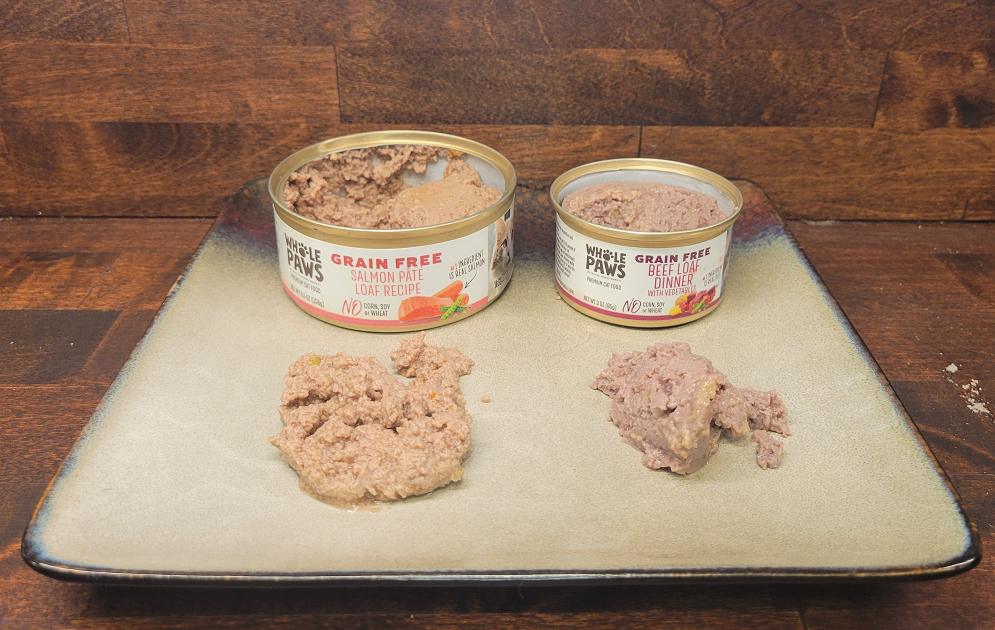
All Whole Paws canned foods have soft, moist textures that are easy to chew for cats of all ages. Kate Barrington / Cats.com
Whole Paws offers a varied selection of dry and wet cat food products as well as treats and cat litter. Though availability may vary by location, the product line appears to include about a dozen products formulated for cats. All Whole Paws cat foods are grain-free.
The wet cat food recipes available from Whole Paws include:
- Salmon Pate Loaf
- Chicken Pate Loaf
- Whitefish Loaf Dinner
- Chicken and Giblets Loaf Dinner with Vegetables
- Tuna Dinner Shredded in a Savory Gravy
- Salmon Dinner Shredded in a Savory Gravy
- Turkey & Giblets Loaf Recipe
- Beef Loaf Dinner with Vegetables
Whole Paws dry cat foods feature either chicken or fish as the primary ingredient. There are four recipes to choose from:
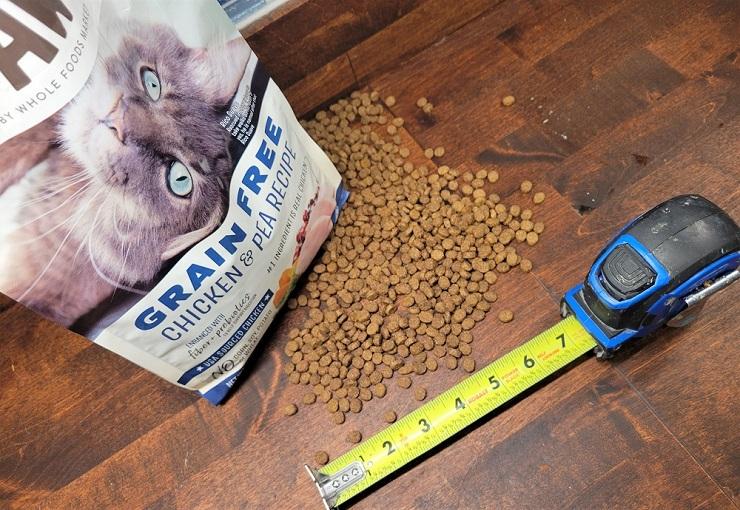
Whole Paws dry cat food comes in small, round kibbles that measure about 1/4-inch in diameter. Kate Barrington / Cats.com
- Grain-Free Chicken Recipe
- Indoor Cat Grain-Free Salmon Recipe
- Grain-Free Ocean-Caught Whitefish Recipe
- Grain-Free Chicken & Pea Recipe
All Whole Paws dry foods are sold in small 3.5-pound bags while their canned foods come in 3-ounce or 5.5-ounce cans.
What Did Our Test Cats Think?
At first glance, Whole Paws cat food seemed just like any other grocery store brand. The dry food kibbles were very small and crunchy while all the wet foods were very moist and soft. My cats seemed to really enjoy the canned foods but didn’t seem particularly interested in the dry food.
Whole Paws Cat Food – Top 3 Recipes Reviewed
| Product Name | Food Type | Main Protein Source | Calories | Price | Our Grade |
| Whole Paws Grain-Free Beef Loaf Dinner with Vegetables Wet Cat Food | Wet | Beef | 34 kcal/oz. | $0.30 per oz | B- |
| Whole Paws Grain-Free Salmon Pate Loaf Recipe Wet Cat Food | Wet | Salmon | 34 kcal/oz. | $0.20 per oz | B |
| Whole Paws Grain-Free Chicken & Pea Recipe Dry Cat Food | Dry | Chicken | 118 kcal/oz. | $0.21 per oz | C |
What Do Customers Think of Whole Paws Cat Food?
Whole Foods Market doesn’t allow customer ratings and reviews on its website, but there are plenty of reviews for Whole Paws pet foods on Amazon.com. The brand seems to be well-liked, with most cat food products having an average rating of at least 4 stars out of 5. That said, relatively few of the reviews were left within the past year.
Positive Reviews
“I have two cats, one having more of a sensitive stomach and this cat food really helps! They seem to like it and it’s a good amount of food for what you pay for!”. —DM, reviewing Whole Paws Indoor Cat Chicken Recipe Dry Food
“My picky eater and my eats-everything both love this wet food. I miss the old beef loaf that they really REALLY loved, but this one is good, too.” —JDN, Reviewing Whole Paws Grain-Free Tuna Dinner Wet Cat Food
Several cat owners reported that even their picky cats like Whole Paws cat food—some refuse anything else. Cats who like one Whole Paws recipe seem to enjoy other flavors as well. There are numerous positive comments about cats enjoying the gravy-like consistency of Whole Paws wet foods.
Negative Reviews
“My cat absolutely loved the Whole Paws Tuna in Gravy. It was the only food he would eat and absolutely loved it. Well thanks a lot Whole Foods. You took it away and replaced it with tuna and chicken, and he won’t even go near
it. Nice move. -cats just want plain tuna not tuna mixed with chicken.!!” —Jon K, Reviewing Whole Paws Grain-Free Tuna Dinner
“This was the ONLY food my picky cat would eat and I bought so many cases until the last two were a totally different look, consistency, they are chunky and not full of gravy. It looks grotesque and my cat will not eat it. Thanks a bunch Whole Foods for screwing over my kitty and wasting my money.”—Lou, Reviewing Whole Paws Grain-Free Tuna Dinner
Negative reviews for Whole Paws cat food are largely centered around individual cat preferences—no pet food is going to be universally well-liked. There are a few comments about the wet food smelling awful or kibbles being too small, but recent reviews don’t raise any major red flags.
How Much Does Whole Paws Cat Food Cost?
When the product line was first launched, Whole Paws was introduced as a value-focused brand. The foods seem to be moderately priced when compared to the pet food market as a whole, but it’s a little more expensive than other private label brands like Aldi’s Heart to Tail and Petco’s WholeHearted.
Customers may appreciate that Whole Paws prices don’t vary based on ingredients. You’ll pay the same amount for a fish-based wet food as for a chicken-based recipe. The 3-ounce wet cat food cans cost $0.89 each, and the larger 5.5-ounce cans are $1.09. This averages out to $0.30 and $0.20 per ounce, respectively.
Whole Paws dry cat foods are available in standard and organic versions, all sold in 3.5-pound bags. The regular adult dry cat food costs $11.79 per bag ($0.21/ounce) while the organic recipes are $20.99 ($0.37). The cost to feed a 10-pound cat Whole Paws food ranges from about $0.35 to $1.75 per day, depending on which product you choose.
Where Is Whole Paws Cat Food Sold?
Because Whole Paws is a private-label brand specifically made for Whole Foods Market, its availability is limited. The best place to buy it is in Whole Foods stores or online at WholeFoodsMarket.com. You may also be able to place an order through grocery delivery services like Instacart. Availability of certain recipes may vary by location.
In addition to being sold in Whole Foods stores and on their website, you can order Whole Paws pet food on Amazon. Keep in mind that the Whole Foods Market store is a separate section of Amazon, so a delivery fee may apply even if you’re an Amazon Prime member.



